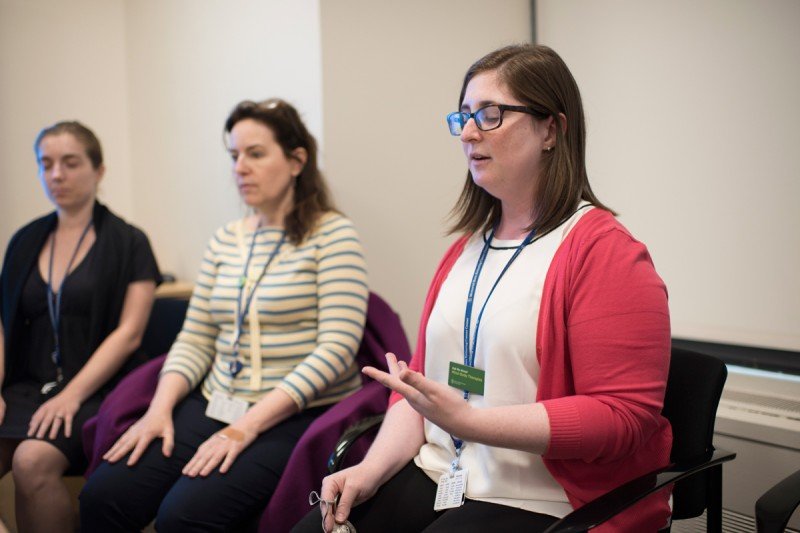
"Meditation teaches us that we are much more resilient than we think," says Emily Herzlin (right), pictured here leading a meditation class for MSK employees.
Can the simple acts of being still, noticing your thoughts, and focusing on your breath really be transformative? Meditation instructor Emily Herzlin offers a resounding yes. Here, she shares how she teaches mindfulness and meditation to people with cancer, their families, and employees at MSK.
When did you start meditating, and what made you want to teach it at MSK?
In high school, a teacher noticed I was having a rough time and gave me a book on meditation. I had all kinds of ideas about what meditation was and what kinds of people practice it, but I had a lot of respect for this teacher and gave it a try. The book offered simple lessons — how to sit, how to breathe, what to do with your mind when it wanders — and it soon became really helpful. Meditation was, for me, a period of the day when I knew I was doing something good for myself and I didn’t have to be running around trying to fix everything. I could just let that go and come back to this moment, which was usually an OK moment. I kept practicing throughout high school, college, and graduate school, and in graduate school I taught a meditation for writers class. I loved it so much that I started looking into more ways to teach it. Seeing how powerful these practices can be when we’re suffering, it makes sense for me to be offering them at MSK. I’m here for everyone: patients, caregivers, family, and staff.
What is a typical day like for you?
My role is mostly in developing and teaching courses and workshops. Some of them are online, and some of them are in person. Every day is different. Right now I’m teaching a variety of meditation courses at the Bendheim Integrative Medicine Center and doing half-hour drop-in meditation and stress-reduction sessions in the Teen and Young Adult Lounge on Wednesdays. Then I do workshops around the hospital. We recently did a stress-reduction workshop for the PhD students and a mindfulness workshop for nurses. I have a lot of flexibility and want to craft things that really address what people need.
How have you seen meditation work at MSK?
It depends on the person. To provide one example: One class participant had a lot of physical pain, and we did this practice called a body scan, in which we slowly move our attention throughout the body and pay attention to sensations. He asked me, “Why would you tell me to pay attention to the pain in my body? I spend my day trying to avoid it.” He came in the next week completely floored by this practice. He noticed that trying to avoid feeling pain was exhausting and that the pain was not even as bad as it was in his mind. The other benefit was that when he was able to pay attention to his pain, he was able to more accurately describe it to his doctor. The body is always in the present moment, so to be able to come back and check in with what’s here and now is a great opportunity for self-care.
How else have you seen it work?
So many people have a fear of recurrence that just takes over. One of the reasons it’s not a problem to have thoughts in meditation is because every time you notice, “I’m thinking,” you can come back to the present moment. That’s a very big practice, just the simplicity of letting a thought be. This isn’t going to eliminate all difficult thoughts, but it’s a tool for when that thought does come up again. There’s a big difference between noticing what you’re thinking and getting caught up in what you’re thinking.
How are your classes structured?
Generally every class will begin with a short meditation to settle in, and then we’ll check in: How did it go this week? There’s an ongoing practice that I invite people to try on a daily basis. It might be taking a few breaths before you check your email or being self-compassionate when you’re in the waiting room. Then we’ll have a longer practice and talk about it after. This is training us to learn that we can choose where we place our attention and that we can choose to place our attention where it’s beneficial. But meditation practice isn’t just that ten, 15, 20 minutes of your day. We want those benefits to carry over into the rest of the day.
What are some misconceptions about meditation, and how do you respond to them?
I’d say the biggest is, “I can’t meditate because I can’t turn off my mind.” And the good news is you don’t have to! Mindfulness is about being with whatever’s happening right now, so if what’s happening is you’re thinking, that’s fine. Just notice that you’re thinking. You don’t have to shut it off.
Another barrier I hear about is not having enough time. I really understand that, especially among patients, caregivers, and MSK staff. I encourage people to do the best they can, even if it’s just five minutes. It’s also an opportunity to look at how we spend our time. Do I need to scroll through Facebook for a half hour? What effect is that having on my mind?
Meditation doesn’t work overnight. How do you encourage people to stick with it?
I encourage people to practice on their own at home. Any skill you want to develop takes practice; that’s why this is called meditation practice. That said, a lot of people find benefits pretty quickly, and a lot of people find the practice itself to be quite soothing.
I encourage people to find the practice that they gravitate toward. In the Meditation 101 class I teach, we do a variety of practices so students can get a sense of them all: breathing, body scan, yoga, loving-kindness, and guided imagery. They’re all a little different and can be soothing to different people at different times.
What does your own meditation practice look like?
I’ve practiced every morning for years now, and all the practices I’m sharing I try to bring into my life. I really try to be as present as possible with my experience, with my breath, with walking, with eating. There are a lot of different techniques that work for me if I feel distressed or overwhelmed: feeling my breath, bringing mindfulness to emotion. We can be so reactive, wanting to change a situation or feel better. I think what makes feelings so scary is that we think they’re going to last forever. But things are impermanent. This is just what’s happening right now. I think that is such a helpful phrase in meditation and in life. [Mindfulness leader and meditation teacher] Jon Kabat-Zinn’s definition of mindfulness is “paying attention, on purpose, in the present moment, without judgment,” and I think that the “without judgment” part is key. You don’t have to get into a battle with this experience. Meditation teaches us that we are much more resilient than we think we are in the face of challenging emotions, thoughts, and sensations. If we’re with it, it’s a lot less scary the next time it comes up.
Why do you think meditation and mindfulness have recently become so popular?
I think today there is a real need and desire for quiet, calm, and peace. At its core, this is a practice that can lead to that, even if just for a few moments during the day. And the peace and clarity that can come from mindfulness help us make beneficial choices and be compassionate toward ourselves and others.


